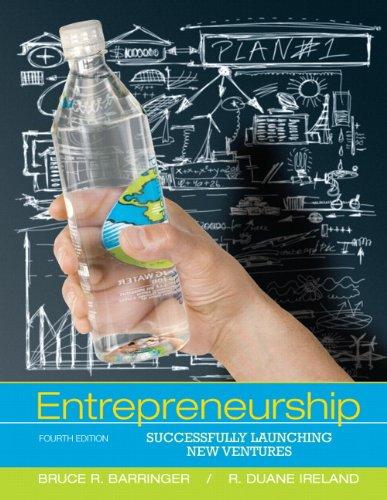Heres a question that a panel of judges recently decided: Can a company patent how it makes
Question:
Here’s a question that a panel of judges recently decided: Can a company patent how it makes a peanut butter and jelly sandwich? More specifically, in this instance, judges considered whether J. M. Smucker’s method of making Uncrustables—which is a crustless peanut butter and jelly sandwich sealed inside soft bread—is worthy of legal protection against imitators.
While the nature of this case is interesting, the legal rulings resulting from the case have broader implications. At stake is how generous the patent office should be in awarding patents—an issue with solid arguments on both sides.
There were actually two cases leading up to the case that resulted in the final verdict. The three cases are designated Round 1, Round 2, and Round 3 of Smucker’s battle to patent the peanut butter and jelly sandwich.
The case involves Smucker’s Uncrustables sandwich. Uncrustables are found in the frozen food section of most grocery stores. They are 2-ounce peanut butter and jelly pockets that come in two flavors—grape and strawberry—and are sealed inside soft bread.
They come in boxes of 4, 10, or 18 sandwiches per box.
To make an Uncrustables ready to eat, the customer simply needs to let it thaw for 30–60 minutes after being taken out of the freezer.
The Uncrustables was developed in 1995 by David Geske, of Fargo, North Dakota, and Len Kretchman, of Fergus Falls, Minnesota. The two started mass-producing them for Midwestern schools.
Smucker’s took note of their success and bought Geske and Kretchman’s company in 1999. The purchase of the company included a general patent on crustless peanut butter and jelly sandwiches (Patent No. 6,004,596) that Geske and Kretchman had obtained.
Round 1: Smucker’s Versus Albie’s Foods
It wasn’t long before Smucker’s was defending its turf.
In 2001, Smucker’s ordered a much smaller firm, Albie’s Foods, to stop selling its own crustless peanut butter and jelly sandwich. Albie’s was selling the sandwich to a local school district. Albie’s fought back, and the case was eventually dismissed. In its arguments, Albie’s contended that the “pasty”—a meat pie with crimped edges, which the company saw its crustless peanut butter and jelly sandwich as a variation of—had been a popular food in northern Michigan since the immigration of copper and iron miners from England in the 1800s.
Round 2: Smucker’s and the Patent Office
Stung by its experience with the case it brought against Albie’s, Smucker’s returned to the USPTO to try to get its general patent on crustless peanut butter and jelly sandwiches broadened as a means of being able to better defend the Uncrustables. The patent office rejected the application. The gist of Smucker’s argument was that its sandwich’s sealed edge is unique and its layering approach, which keeps the jelly in the middle of the sandwich, is one-of-a-kind, and as such, should be protected by law. The patent office disagreed with this view. It said that the crimped edge,
which was one of the things Smucker’s argued was unique about its sandwich, is similar to the crimped edges in ravioli and pie crusts. In addition, the patent office determined that putting jelly in the middle of a peanut butter and jelly sandwich is hardly unique, and as evidence cited a 1994 Wichita (Kansas) Eagle newspaper article on back-to-school tips that suggested just this approach.
Round 3: Smucker’s Appeals
Smucker’s appealed the patent office’s decision to the U.S. Court of Appeals. During the court hearings the attorney representing Smucker’s argued that the method for making the Uncrustables is unique because the two slices of bread are sealed by compression but are not “smashed” as they are in tarts or ravioli. (Recall, the patent office’s original decision compared the process of making Uncrustables to that of making ravioli.) Smucker’s further argued that it wouldn’t be fair to let other companies simply copy the Uncrustables and benefit from the hard work of Smucker’s scientists and the money that the company had invested to produce what it believed was a unique product. The Uncrustables is also a big seller for Smucker’s.
According to a Wall Street Journal article, the product generated sales of $27.5 million in 2004.
Discussion Questions
1. Go to the USPTO’s Web site (www.uspto.gov) to look up Patent No. 6,004,596. Read the patent. After reading the patent, are you more inclined or less inclined to side with the Smucker’s point of view?
2. Type “Uncrustables” into the Google search engine and look at the Uncrustables sandwich. Spend a little time reading about the Uncrustables on Smucker’s Web site. Again, after looking over the Web site, are you more inclined or less inclined to side with the Smucker’s point of view?
3. In regard to the arguments espoused by the “critics” of the U.S. patent system and the “advocates” of the U.S. patent system, which of the points of view do you agree with? Thinking as an entrepreneur, use your own words to state why you think the critics or the advocates have a stronger point of view.
4. So what do you think happened? Do you think Smucker’s did or didn’t get the patent it was requesting?
Application Questions
1. What would be the impact, if any, on the entrepreneurial sector of the U.S. economy if patents became increasingly hard to get? Would it help or hurt the majority of entrepreneurial companies? Why?
2. Based on the material in the chapter, are there facets of the U.S. patent system and, in particular, the operations of the USPTO that you think need to be improved or changed? What are these facets? Using the perspective of an entrepreneur, what changes do you believe should be made?
Step by Step Answer:

Entrepreneurship Successfully Launching New Ventures
ISBN: 9780132555524
4th Edition
Authors: Bruce R. Barringer, R. Duane Ireland





